Marianne's Heaven On Earth Aurora Chaser Tours Chasethelighttours.co.uk invites you to join them in their quest to find and photograph the Aurora Borealis. Experience the winter wonderland in the Tromsø Area. | | | SUNDIVING COMET: By the time you finish reading this news item, the solar system could have one less comet. Yesterday, Dec. 7th, the Solar and Heliospheric Observatory (SOHO) spotted a comet diving toward the sun. Today, Dec. 8th, it is vaporizing furiously in the solar corona: 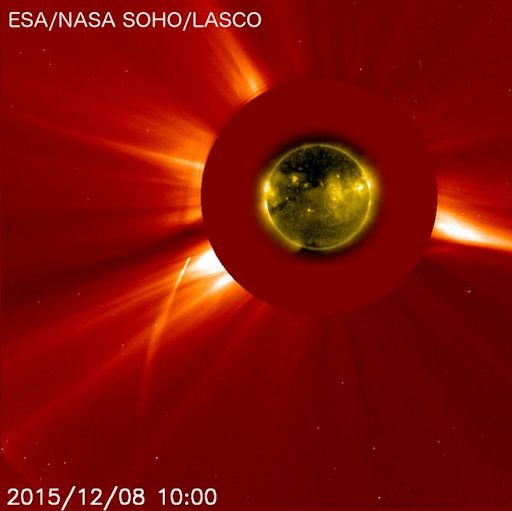
The comet is a member of the Kreutz family--fragments from the breakup of a single giant comet many centuries ago. They get their name from 19th century German astronomer Heinrich Kreutz, who studied them in detail. Several Kreutz fragments pass by the sun and disintegrate every day. Most, measuring less than a few meters across, are too small to see, but occasionally a bigger fragment like this one (~10 m to 50 m) attracts attention. The comet was first noticed in SOHO images by Polish amateur astronomer Szymon Liwo. Judging from the latest SOHO images, his discovery won't last much longer. In fact, the comet's nucleus may have already disintegrated, leaving only a disembodied tail. Because of their common parentage, sungrazers often come in clusters. For this reason, it wouldn't be surprising to find yet another one in the offing. Monitor Karl Battam's Sungrazing Comet twitter feed for more sightings. Realtime Comet Photo Gallery POLAR GEOMAGNETIC STORMS: Earth is moving through a broad stream of solar wind flowing from a coronal hole on the sun. As a result, auroras are dancing around the Arctic Circle. Photographer Ruslan Merzlyakov saw the show, last night, from the window seat of an airplane flying over the Barents Sea: 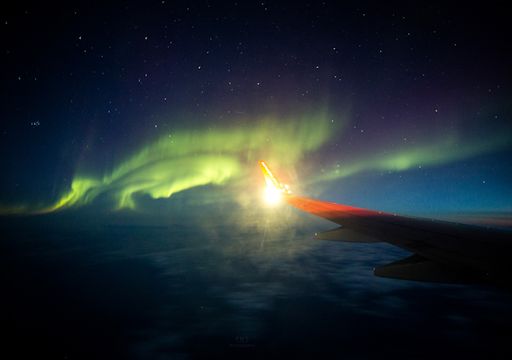
"We were just south of Svalbard when the auroras appeared," says Merzlyakov. "It was the best flight ever." Earth will remain under the influence of this solar wind stream for the next two or three days. During that time, polar geomagnetic storm probabilities are as high as 50%, according to NOAA. If you're flying at high latitudes this week, be sure to grab a window seat. Aurora alerts: text or voice Realtime Aurora Photo Gallery DAYTIME OCCULTATION OF VENUS: On Monday, Dec. 7th, people in North America saw something remarkable in the daytime sky: the crescent Moon passed directly in front of Venus and covered it. Moments before the second planet disappeared, David Pinsky of West Hollywood CA took this picture: 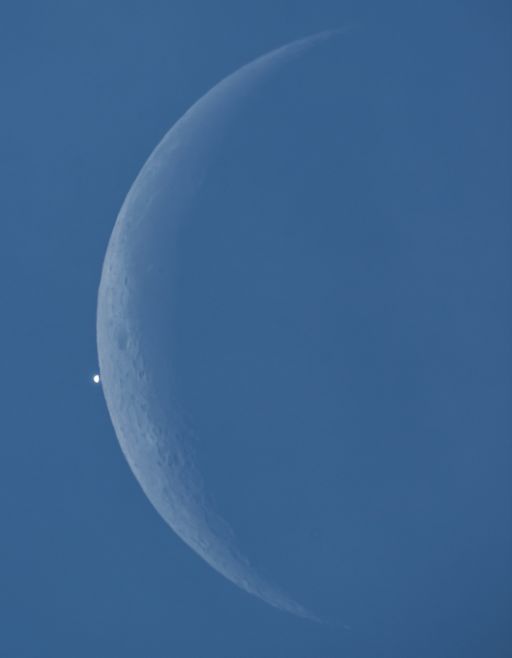
"This was the view through my Canon Rebel T3i digital camera placed at the prime focus of a Celestron 5 inch Maksutov telescope," says Pinsky. Venus remained behind the Moon for more than an hour, then popped into view again on the opposite lunar limb. The convergence of the Moon and Venus were plainly visible to the unaided eye from Canada, Mexico, and 49 of 50 US States. Only Hawaii was left out. Browse the gallery for more beautiful views from the occultation zone: Realtime Space Weather Photo Gallery
Realtime Noctilucent Cloud Photo Gallery
Realtime Meteor Photo Gallery Every night, a network of NASA all-sky cameras scans the skies above the United States for meteoritic fireballs. Automated software maintained by NASA's Meteoroid Environment Office calculates their orbits, velocity, penetration depth in Earth's atmosphere and many other characteristics. Daily results are presented here on Spaceweather.com. On Dec. 8, 2015, the network reported 72 fireballs.
(55 sporadics, 7 sigma Hydrids, 5 Geminids, 3 November omega Orionids, 1 Quadrantid, 1 alpha Canis Majorid) 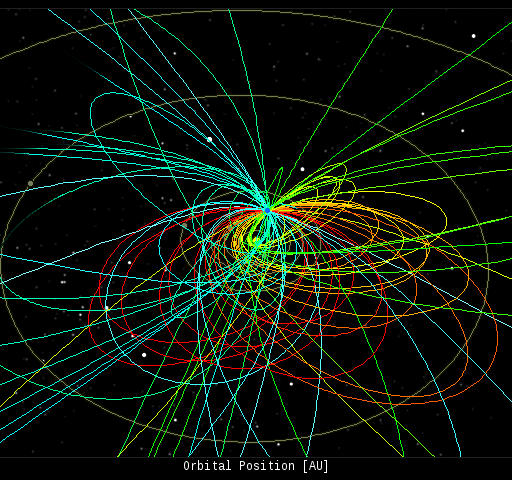 In this diagram of the inner solar system, all of the fireball orbits intersect at a single point--Earth. The orbits are color-coded by velocity, from slow (red) to fast (blue). [Larger image] [movies] Potentially Hazardous Asteroids ( PHAs) are space rocks larger than approximately 100m that can come closer to Earth than 0.05 AU. None of the known PHAs is on a collision course with our planet, although astronomers are finding new ones all the time. On December 8, 2015 there were potentially hazardous asteroids. Notes: LD means "Lunar Distance." 1 LD = 384,401 km, the distance between Earth and the Moon. 1 LD also equals 0.00256 AU. MAG is the visual magnitude of the asteroid on the date of closest approach. | | Cosmic Rays in the Atmosphere | | Situation Report -- Oct. 30, 2015 | Stratospheric Radiation (+37o N) | | Cosmic ray levels are elevated (+6.1% above the Space Age median). The trend is flat. Cosmic ray levels have increased +0% in the past month. | | Sept. 06: 4.14 uSv/hr (414 uRad/hr) | | Sept. 12: 4.09 uSv/hr (409 uRad/hr) | | Sept. 23: 4.12 uSv/hr (412 uRad/hr) | | Sept. 25: 4.16 uSv/hr (416 uRad/hr) | | Sept. 27: 4.13 uSv/hr (413 uRad/hr) | | Oct. 11: 4.02 uSv/hr (402 uRad/hr) | | Oct. 22: 4.11 uSv/hr (411 uRad/hr) | These measurements are based on regular space weather balloon flights: learn more. Approximately once a week, Spaceweather.com and the students of Earth to Sky Calculus fly "space weather balloons" to the stratosphere over California. These balloons are equipped with radiation sensors that detect cosmic rays, a surprisingly "down to Earth" form of space weather. Cosmic rays can seed clouds, trigger lightning, and penetrate commercial airplanes. Our measurements show that someone flying back and forth across the continental USA, just once, can absorb as much ionizing radiation as 2 to 5 dental X-rays. Here is the data from our latest flight, Oct. 22nd: 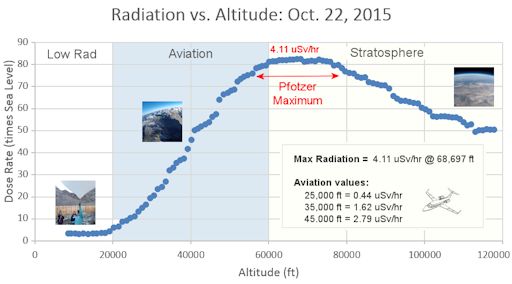
Radiation levels peak at the entrance to the stratosphere in a broad region called the "Pfotzer Maximum." This peak is named after physicist George Pfotzer who discovered it using balloons and Geiger tubes in the 1930s. Radiation levels there are more than 80x sea level. Note that the bottom of the Pfotzer Maximim is near 55,000 ft. This means that some high-flying aircraft are not far from the zone of maximum radiation. Indeed, according to the Oct 22th measurements, a plane flying at 45,000 feet is exposed to 2.79 uSv/hr. At that rate, a passenger would absorb about one dental X-ray's worth of radiation in about 5 hours. The radiation sensors onboard our helium balloons detect X-rays and gamma-rays in the energy range 10 keV to 20 MeV. These energies span the range of medical X-ray machines and airport security scanners. | | The official U.S. government space weather bureau | | | The first place to look for information about sundogs, pillars, rainbows and related phenomena. | | | Researchers call it a "Hubble for the sun." SDO is the most advanced solar observatory ever. | | | 3D views of the sun from NASA's Solar and Terrestrial Relations Observatory | | | Realtime and archival images of the Sun from SOHO. | | | from the NOAA Space Environment Center | | | the underlying science of space weather | | | a sponsor of SpaceWeather.com | | | Web-based high school science course with free enrollment | | | the underlying science of space weather | | 
